BUSN11080: NHS Performance Management Consultancy Report
VerifiedAdded on 2023/01/12
|11
|3267
|94
Report
AI Summary
This report analyzes the organizational performance management (OPM) system of the National Health Service (NHS), a rapidly growing healthcare organization. The analysis covers various aspects, including OPM, performance measurement tools, communication with stakeholders, risk management, quality management, financial performance, customer perspectives, and people perspectives. The report examines the existing system's strengths and weaknesses, providing insights into areas such as strategic business plans, risk assessment, and quality improvement strategies. It also explores financial monitoring, customer satisfaction, and employee perspectives. The report concludes with recommendations for improving the NHS's OPM system, aiming to enhance its efficiency, effectiveness, and overall performance in delivering healthcare services to the public. The report is structured according to the assignment brief and includes an introduction, analysis, recommendations, and a conclusion, along with references.
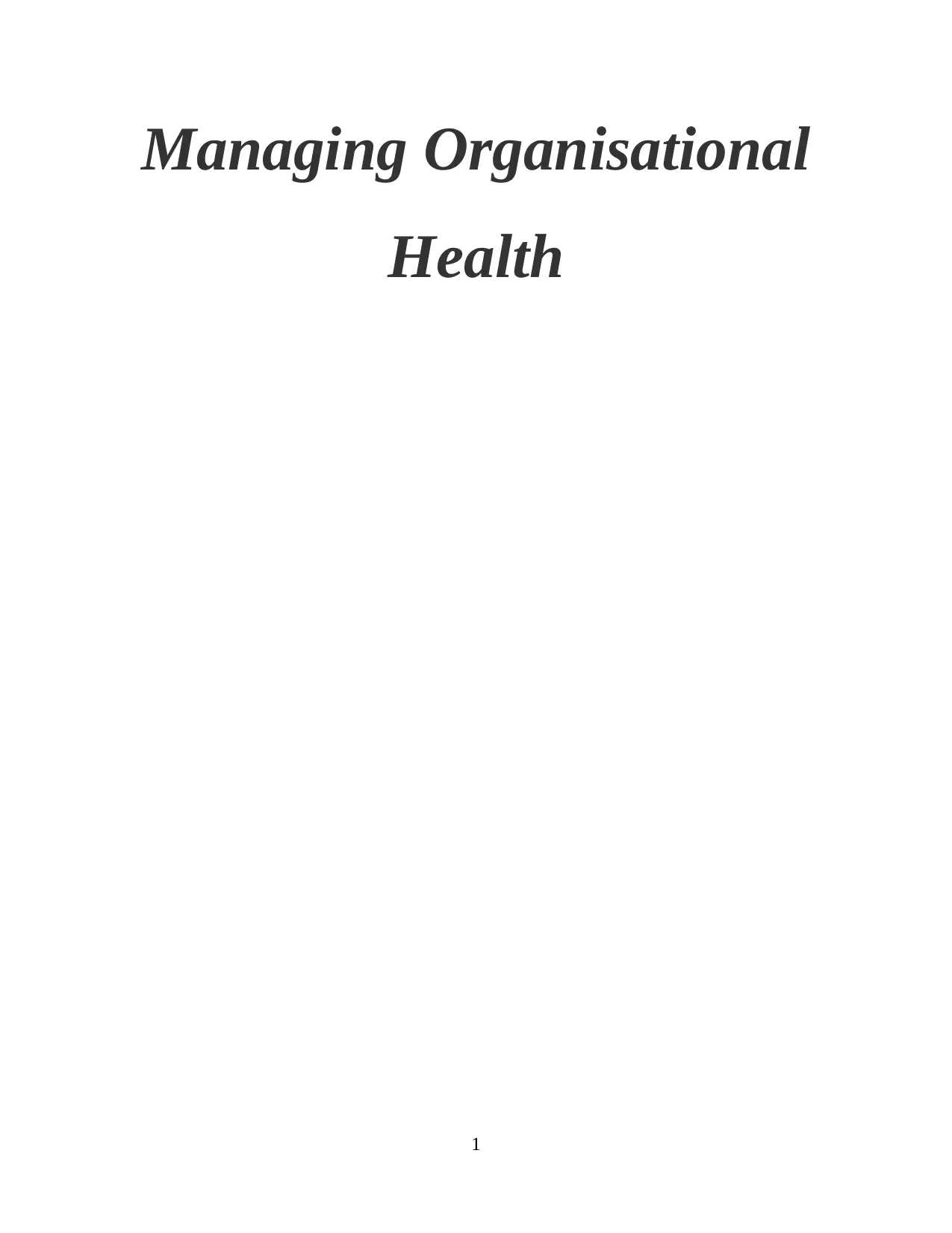
Managing Organisational
Health
1
Health
1
Paraphrase This Document
Need a fresh take? Get an instant paraphrase of this document with our AI Paraphraser
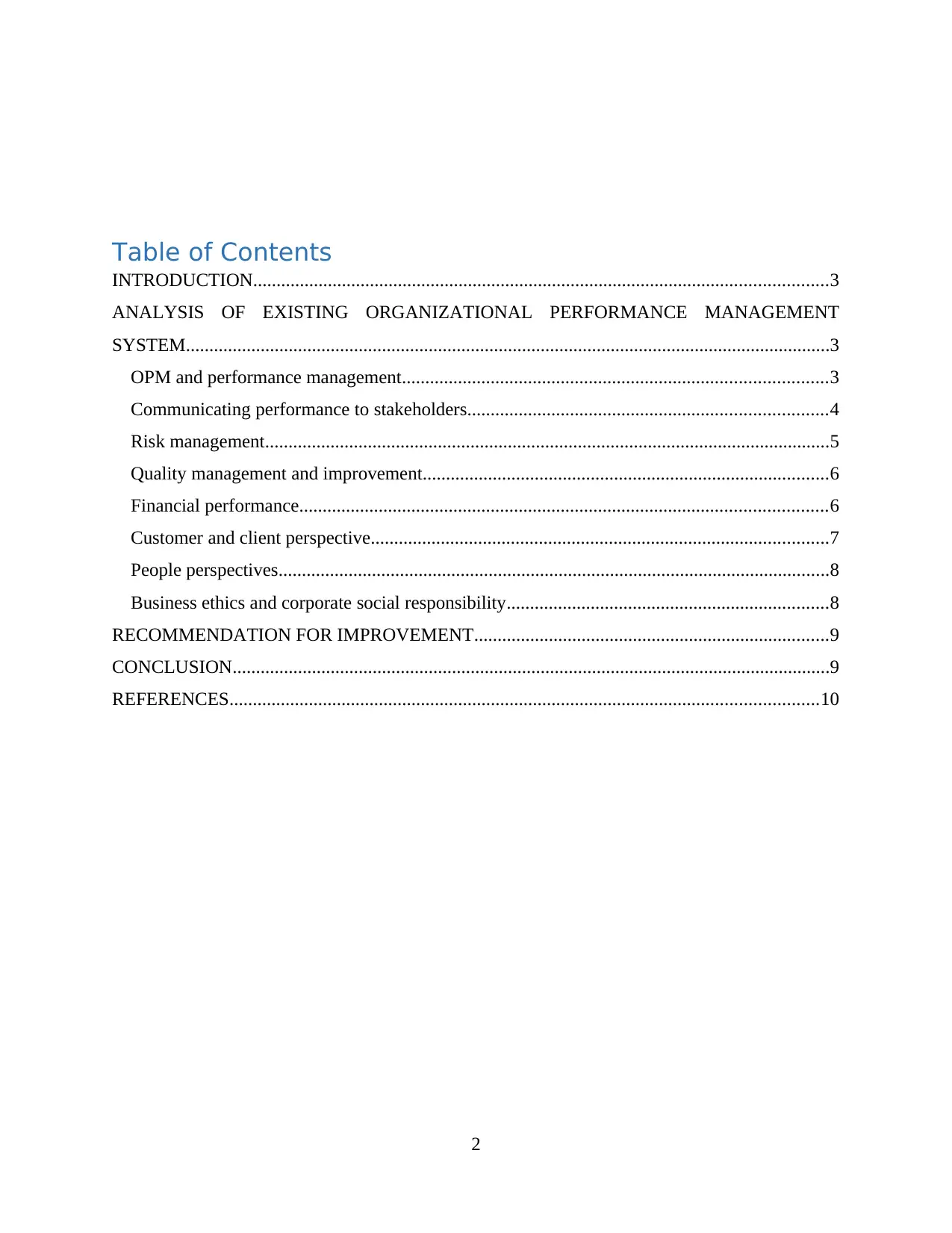
Table of Contents
INTRODUCTION...........................................................................................................................3
ANALYSIS OF EXISTING ORGANIZATIONAL PERFORMANCE MANAGEMENT
SYSTEM..........................................................................................................................................3
OPM and performance management...........................................................................................3
Communicating performance to stakeholders.............................................................................4
Risk management.........................................................................................................................5
Quality management and improvement.......................................................................................6
Financial performance.................................................................................................................6
Customer and client perspective..................................................................................................7
People perspectives......................................................................................................................8
Business ethics and corporate social responsibility.....................................................................8
RECOMMENDATION FOR IMPROVEMENT............................................................................9
CONCLUSION................................................................................................................................9
REFERENCES..............................................................................................................................10
2
INTRODUCTION...........................................................................................................................3
ANALYSIS OF EXISTING ORGANIZATIONAL PERFORMANCE MANAGEMENT
SYSTEM..........................................................................................................................................3
OPM and performance management...........................................................................................3
Communicating performance to stakeholders.............................................................................4
Risk management.........................................................................................................................5
Quality management and improvement.......................................................................................6
Financial performance.................................................................................................................6
Customer and client perspective..................................................................................................7
People perspectives......................................................................................................................8
Business ethics and corporate social responsibility.....................................................................8
RECOMMENDATION FOR IMPROVEMENT............................................................................9
CONCLUSION................................................................................................................................9
REFERENCES..............................................................................................................................10
2

3
⊘ This is a preview!⊘
Do you want full access?
Subscribe today to unlock all pages.

Trusted by 1+ million students worldwide
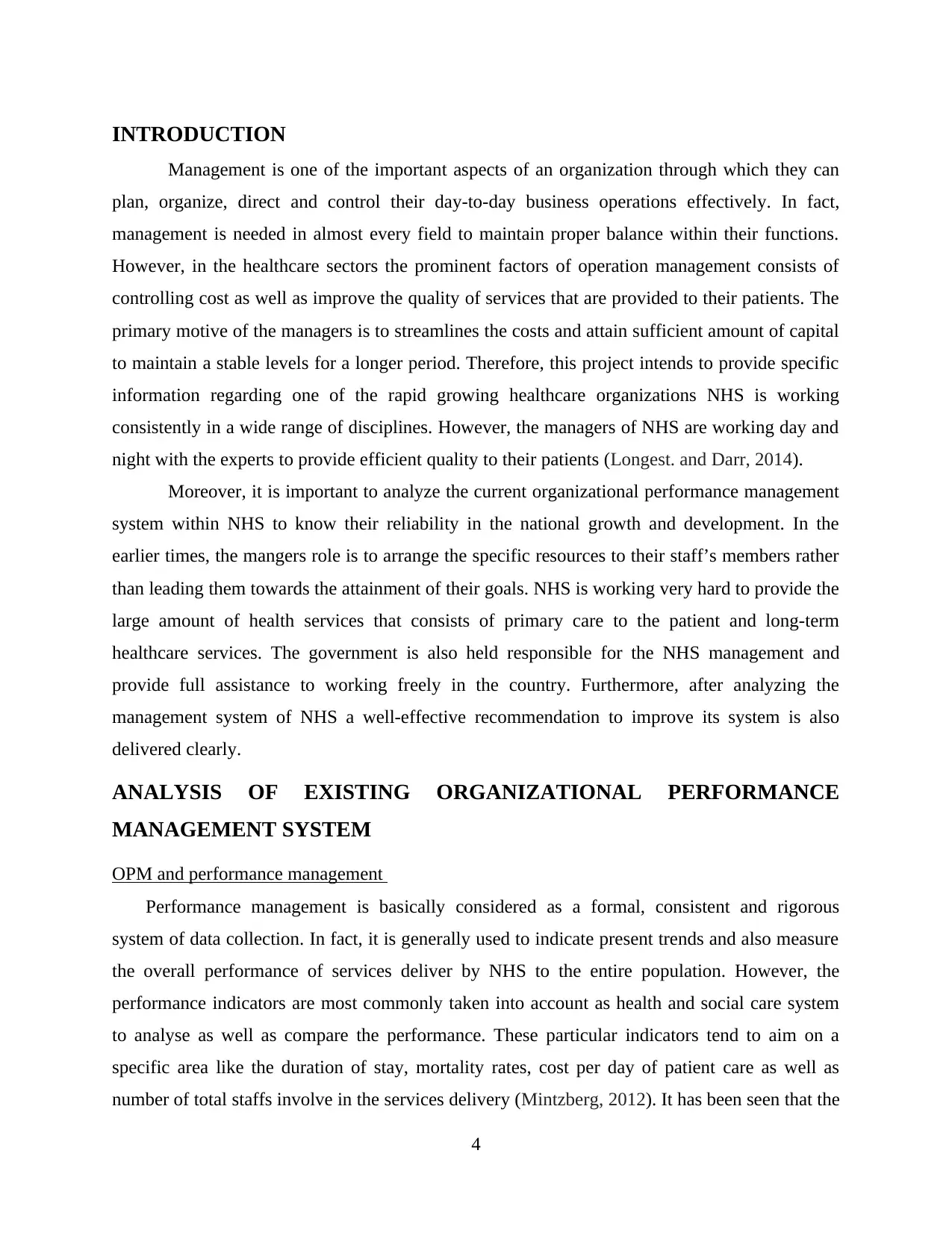
INTRODUCTION
Management is one of the important aspects of an organization through which they can
plan, organize, direct and control their day-to-day business operations effectively. In fact,
management is needed in almost every field to maintain proper balance within their functions.
However, in the healthcare sectors the prominent factors of operation management consists of
controlling cost as well as improve the quality of services that are provided to their patients. The
primary motive of the managers is to streamlines the costs and attain sufficient amount of capital
to maintain a stable levels for a longer period. Therefore, this project intends to provide specific
information regarding one of the rapid growing healthcare organizations NHS is working
consistently in a wide range of disciplines. However, the managers of NHS are working day and
night with the experts to provide efficient quality to their patients (Longest. and Darr, 2014).
Moreover, it is important to analyze the current organizational performance management
system within NHS to know their reliability in the national growth and development. In the
earlier times, the mangers role is to arrange the specific resources to their staff’s members rather
than leading them towards the attainment of their goals. NHS is working very hard to provide the
large amount of health services that consists of primary care to the patient and long-term
healthcare services. The government is also held responsible for the NHS management and
provide full assistance to working freely in the country. Furthermore, after analyzing the
management system of NHS a well-effective recommendation to improve its system is also
delivered clearly.
ANALYSIS OF EXISTING ORGANIZATIONAL PERFORMANCE
MANAGEMENT SYSTEM
OPM and performance management
Performance management is basically considered as a formal, consistent and rigorous
system of data collection. In fact, it is generally used to indicate present trends and also measure
the overall performance of services deliver by NHS to the entire population. However, the
performance indicators are most commonly taken into account as health and social care system
to analyse as well as compare the performance. These particular indicators tend to aim on a
specific area like the duration of stay, mortality rates, cost per day of patient care as well as
number of total staffs involve in the services delivery (Mintzberg, 2012). It has been seen that the
4
Management is one of the important aspects of an organization through which they can
plan, organize, direct and control their day-to-day business operations effectively. In fact,
management is needed in almost every field to maintain proper balance within their functions.
However, in the healthcare sectors the prominent factors of operation management consists of
controlling cost as well as improve the quality of services that are provided to their patients. The
primary motive of the managers is to streamlines the costs and attain sufficient amount of capital
to maintain a stable levels for a longer period. Therefore, this project intends to provide specific
information regarding one of the rapid growing healthcare organizations NHS is working
consistently in a wide range of disciplines. However, the managers of NHS are working day and
night with the experts to provide efficient quality to their patients (Longest. and Darr, 2014).
Moreover, it is important to analyze the current organizational performance management
system within NHS to know their reliability in the national growth and development. In the
earlier times, the mangers role is to arrange the specific resources to their staff’s members rather
than leading them towards the attainment of their goals. NHS is working very hard to provide the
large amount of health services that consists of primary care to the patient and long-term
healthcare services. The government is also held responsible for the NHS management and
provide full assistance to working freely in the country. Furthermore, after analyzing the
management system of NHS a well-effective recommendation to improve its system is also
delivered clearly.
ANALYSIS OF EXISTING ORGANIZATIONAL PERFORMANCE
MANAGEMENT SYSTEM
OPM and performance management
Performance management is basically considered as a formal, consistent and rigorous
system of data collection. In fact, it is generally used to indicate present trends and also measure
the overall performance of services deliver by NHS to the entire population. However, the
performance indicators are most commonly taken into account as health and social care system
to analyse as well as compare the performance. These particular indicators tend to aim on a
specific area like the duration of stay, mortality rates, cost per day of patient care as well as
number of total staffs involve in the services delivery (Mintzberg, 2012). It has been seen that the
4
Paraphrase This Document
Need a fresh take? Get an instant paraphrase of this document with our AI Paraphraser
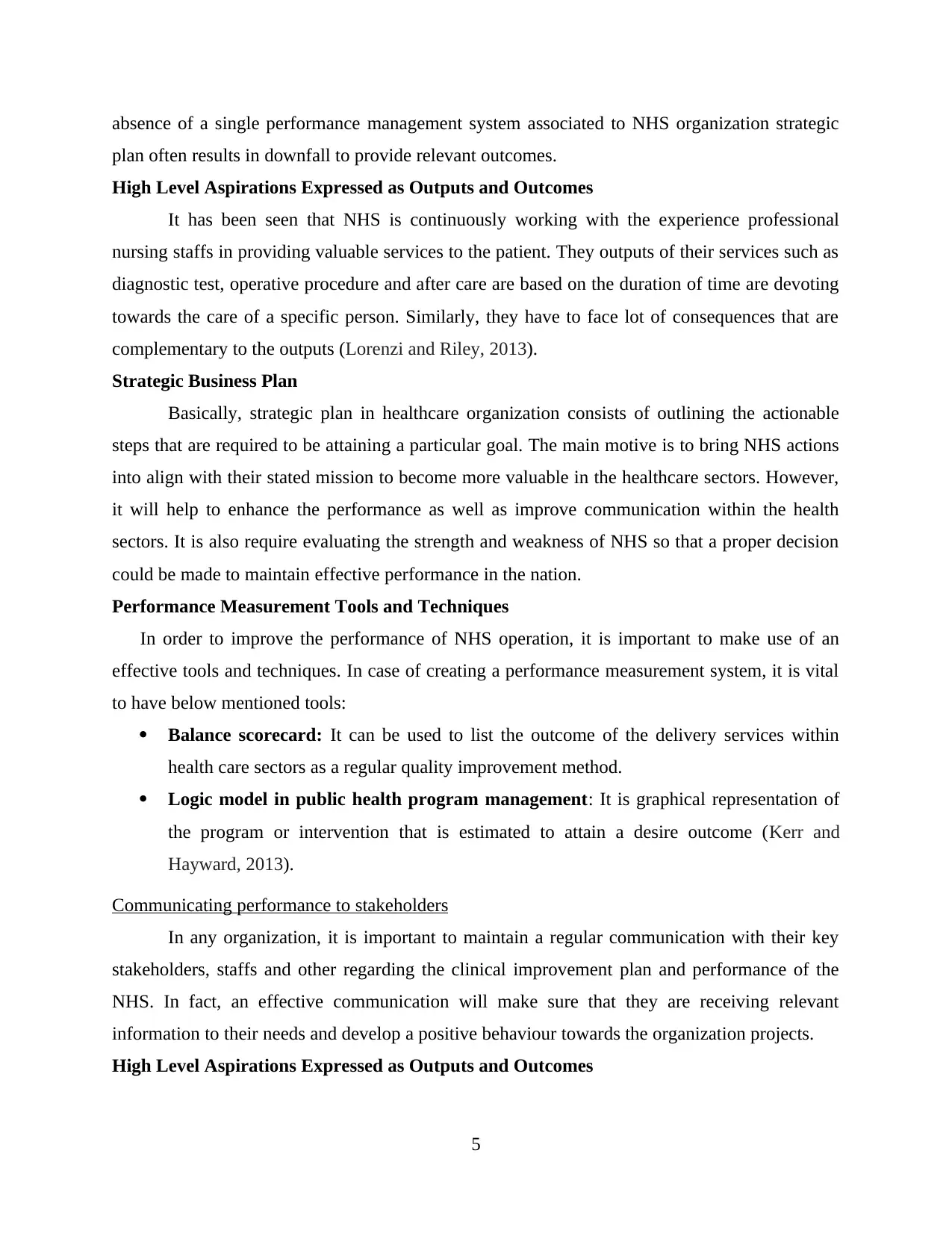
absence of a single performance management system associated to NHS organization strategic
plan often results in downfall to provide relevant outcomes.
High Level Aspirations Expressed as Outputs and Outcomes
It has been seen that NHS is continuously working with the experience professional
nursing staffs in providing valuable services to the patient. They outputs of their services such as
diagnostic test, operative procedure and after care are based on the duration of time are devoting
towards the care of a specific person. Similarly, they have to face lot of consequences that are
complementary to the outputs (Lorenzi and Riley, 2013).
Strategic Business Plan
Basically, strategic plan in healthcare organization consists of outlining the actionable
steps that are required to be attaining a particular goal. The main motive is to bring NHS actions
into align with their stated mission to become more valuable in the healthcare sectors. However,
it will help to enhance the performance as well as improve communication within the health
sectors. It is also require evaluating the strength and weakness of NHS so that a proper decision
could be made to maintain effective performance in the nation.
Performance Measurement Tools and Techniques
In order to improve the performance of NHS operation, it is important to make use of an
effective tools and techniques. In case of creating a performance measurement system, it is vital
to have below mentioned tools:
Balance scorecard: It can be used to list the outcome of the delivery services within
health care sectors as a regular quality improvement method.
Logic model in public health program management: It is graphical representation of
the program or intervention that is estimated to attain a desire outcome (Kerr and
Hayward, 2013).
Communicating performance to stakeholders
In any organization, it is important to maintain a regular communication with their key
stakeholders, staffs and other regarding the clinical improvement plan and performance of the
NHS. In fact, an effective communication will make sure that they are receiving relevant
information to their needs and develop a positive behaviour towards the organization projects.
High Level Aspirations Expressed as Outputs and Outcomes
5
plan often results in downfall to provide relevant outcomes.
High Level Aspirations Expressed as Outputs and Outcomes
It has been seen that NHS is continuously working with the experience professional
nursing staffs in providing valuable services to the patient. They outputs of their services such as
diagnostic test, operative procedure and after care are based on the duration of time are devoting
towards the care of a specific person. Similarly, they have to face lot of consequences that are
complementary to the outputs (Lorenzi and Riley, 2013).
Strategic Business Plan
Basically, strategic plan in healthcare organization consists of outlining the actionable
steps that are required to be attaining a particular goal. The main motive is to bring NHS actions
into align with their stated mission to become more valuable in the healthcare sectors. However,
it will help to enhance the performance as well as improve communication within the health
sectors. It is also require evaluating the strength and weakness of NHS so that a proper decision
could be made to maintain effective performance in the nation.
Performance Measurement Tools and Techniques
In order to improve the performance of NHS operation, it is important to make use of an
effective tools and techniques. In case of creating a performance measurement system, it is vital
to have below mentioned tools:
Balance scorecard: It can be used to list the outcome of the delivery services within
health care sectors as a regular quality improvement method.
Logic model in public health program management: It is graphical representation of
the program or intervention that is estimated to attain a desire outcome (Kerr and
Hayward, 2013).
Communicating performance to stakeholders
In any organization, it is important to maintain a regular communication with their key
stakeholders, staffs and other regarding the clinical improvement plan and performance of the
NHS. In fact, an effective communication will make sure that they are receiving relevant
information to their needs and develop a positive behaviour towards the organization projects.
High Level Aspirations Expressed as Outputs and Outcomes
5
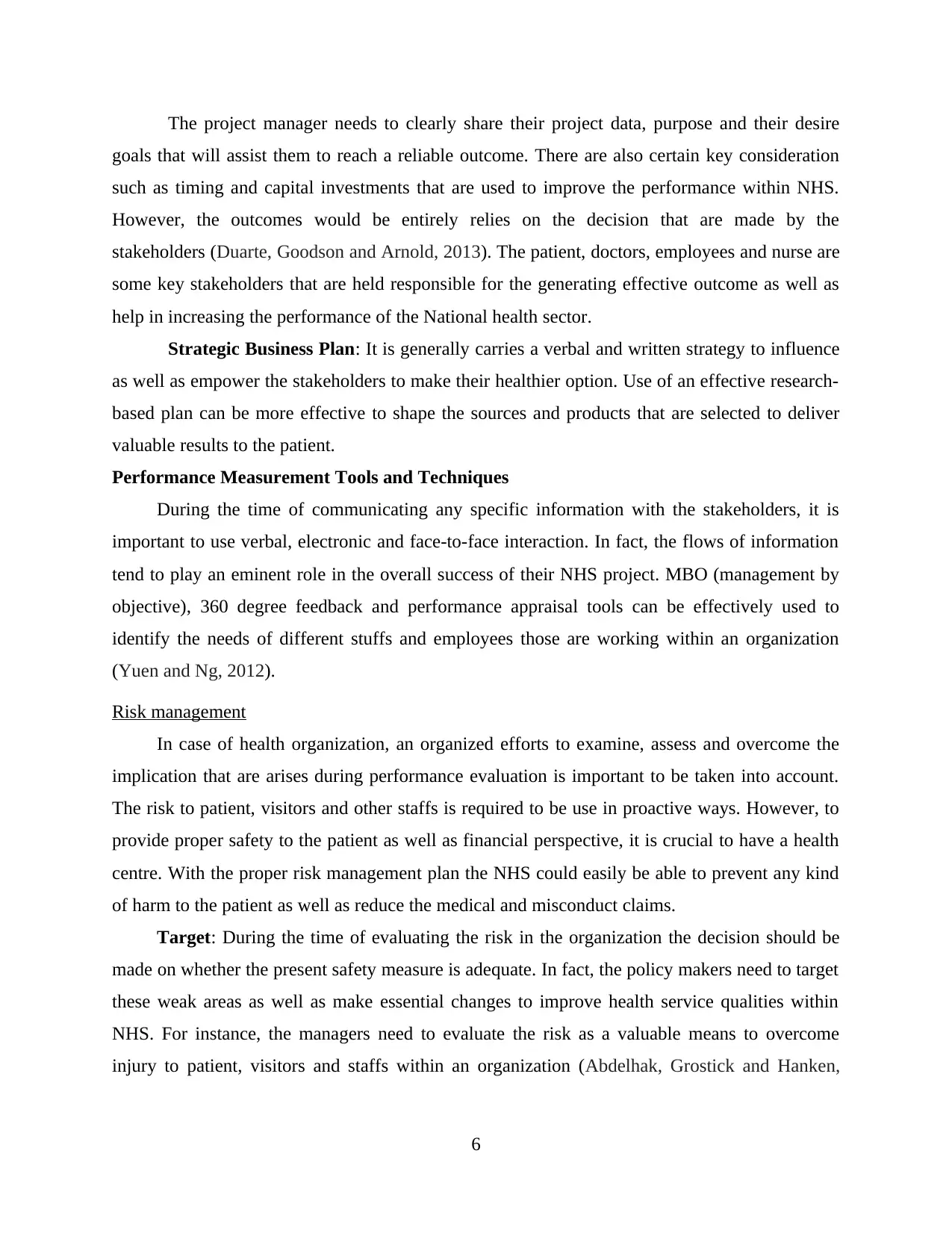
The project manager needs to clearly share their project data, purpose and their desire
goals that will assist them to reach a reliable outcome. There are also certain key consideration
such as timing and capital investments that are used to improve the performance within NHS.
However, the outcomes would be entirely relies on the decision that are made by the
stakeholders (Duarte, Goodson and Arnold, 2013). The patient, doctors, employees and nurse are
some key stakeholders that are held responsible for the generating effective outcome as well as
help in increasing the performance of the National health sector.
Strategic Business Plan: It is generally carries a verbal and written strategy to influence
as well as empower the stakeholders to make their healthier option. Use of an effective research-
based plan can be more effective to shape the sources and products that are selected to deliver
valuable results to the patient.
Performance Measurement Tools and Techniques
During the time of communicating any specific information with the stakeholders, it is
important to use verbal, electronic and face-to-face interaction. In fact, the flows of information
tend to play an eminent role in the overall success of their NHS project. MBO (management by
objective), 360 degree feedback and performance appraisal tools can be effectively used to
identify the needs of different stuffs and employees those are working within an organization
(Yuen and Ng, 2012).
Risk management
In case of health organization, an organized efforts to examine, assess and overcome the
implication that are arises during performance evaluation is important to be taken into account.
The risk to patient, visitors and other staffs is required to be use in proactive ways. However, to
provide proper safety to the patient as well as financial perspective, it is crucial to have a health
centre. With the proper risk management plan the NHS could easily be able to prevent any kind
of harm to the patient as well as reduce the medical and misconduct claims.
Target: During the time of evaluating the risk in the organization the decision should be
made on whether the present safety measure is adequate. In fact, the policy makers need to target
these weak areas as well as make essential changes to improve health service qualities within
NHS. For instance, the managers need to evaluate the risk as a valuable means to overcome
injury to patient, visitors and staffs within an organization (Abdelhak, Grostick and Hanken,
6
goals that will assist them to reach a reliable outcome. There are also certain key consideration
such as timing and capital investments that are used to improve the performance within NHS.
However, the outcomes would be entirely relies on the decision that are made by the
stakeholders (Duarte, Goodson and Arnold, 2013). The patient, doctors, employees and nurse are
some key stakeholders that are held responsible for the generating effective outcome as well as
help in increasing the performance of the National health sector.
Strategic Business Plan: It is generally carries a verbal and written strategy to influence
as well as empower the stakeholders to make their healthier option. Use of an effective research-
based plan can be more effective to shape the sources and products that are selected to deliver
valuable results to the patient.
Performance Measurement Tools and Techniques
During the time of communicating any specific information with the stakeholders, it is
important to use verbal, electronic and face-to-face interaction. In fact, the flows of information
tend to play an eminent role in the overall success of their NHS project. MBO (management by
objective), 360 degree feedback and performance appraisal tools can be effectively used to
identify the needs of different stuffs and employees those are working within an organization
(Yuen and Ng, 2012).
Risk management
In case of health organization, an organized efforts to examine, assess and overcome the
implication that are arises during performance evaluation is important to be taken into account.
The risk to patient, visitors and other staffs is required to be use in proactive ways. However, to
provide proper safety to the patient as well as financial perspective, it is crucial to have a health
centre. With the proper risk management plan the NHS could easily be able to prevent any kind
of harm to the patient as well as reduce the medical and misconduct claims.
Target: During the time of evaluating the risk in the organization the decision should be
made on whether the present safety measure is adequate. In fact, the policy makers need to target
these weak areas as well as make essential changes to improve health service qualities within
NHS. For instance, the managers need to evaluate the risk as a valuable means to overcome
injury to patient, visitors and staffs within an organization (Abdelhak, Grostick and Hanken,
6
⊘ This is a preview!⊘
Do you want full access?
Subscribe today to unlock all pages.

Trusted by 1+ million students worldwide
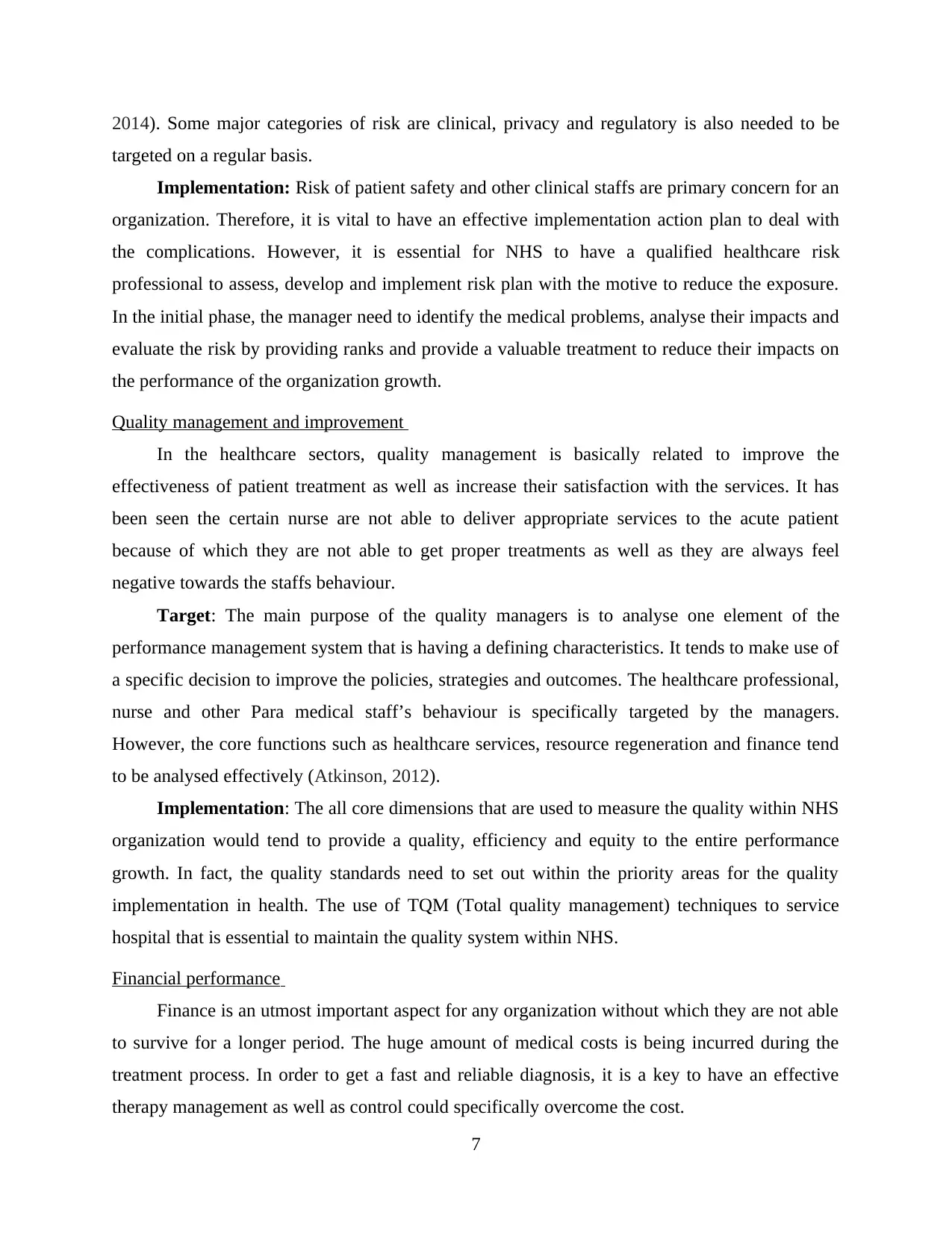
2014). Some major categories of risk are clinical, privacy and regulatory is also needed to be
targeted on a regular basis.
Implementation: Risk of patient safety and other clinical staffs are primary concern for an
organization. Therefore, it is vital to have an effective implementation action plan to deal with
the complications. However, it is essential for NHS to have a qualified healthcare risk
professional to assess, develop and implement risk plan with the motive to reduce the exposure.
In the initial phase, the manager need to identify the medical problems, analyse their impacts and
evaluate the risk by providing ranks and provide a valuable treatment to reduce their impacts on
the performance of the organization growth.
Quality management and improvement
In the healthcare sectors, quality management is basically related to improve the
effectiveness of patient treatment as well as increase their satisfaction with the services. It has
been seen the certain nurse are not able to deliver appropriate services to the acute patient
because of which they are not able to get proper treatments as well as they are always feel
negative towards the staffs behaviour.
Target: The main purpose of the quality managers is to analyse one element of the
performance management system that is having a defining characteristics. It tends to make use of
a specific decision to improve the policies, strategies and outcomes. The healthcare professional,
nurse and other Para medical staff’s behaviour is specifically targeted by the managers.
However, the core functions such as healthcare services, resource regeneration and finance tend
to be analysed effectively (Atkinson, 2012).
Implementation: The all core dimensions that are used to measure the quality within NHS
organization would tend to provide a quality, efficiency and equity to the entire performance
growth. In fact, the quality standards need to set out within the priority areas for the quality
implementation in health. The use of TQM (Total quality management) techniques to service
hospital that is essential to maintain the quality system within NHS.
Financial performance
Finance is an utmost important aspect for any organization without which they are not able
to survive for a longer period. The huge amount of medical costs is being incurred during the
treatment process. In order to get a fast and reliable diagnosis, it is a key to have an effective
therapy management as well as control could specifically overcome the cost.
7
targeted on a regular basis.
Implementation: Risk of patient safety and other clinical staffs are primary concern for an
organization. Therefore, it is vital to have an effective implementation action plan to deal with
the complications. However, it is essential for NHS to have a qualified healthcare risk
professional to assess, develop and implement risk plan with the motive to reduce the exposure.
In the initial phase, the manager need to identify the medical problems, analyse their impacts and
evaluate the risk by providing ranks and provide a valuable treatment to reduce their impacts on
the performance of the organization growth.
Quality management and improvement
In the healthcare sectors, quality management is basically related to improve the
effectiveness of patient treatment as well as increase their satisfaction with the services. It has
been seen the certain nurse are not able to deliver appropriate services to the acute patient
because of which they are not able to get proper treatments as well as they are always feel
negative towards the staffs behaviour.
Target: The main purpose of the quality managers is to analyse one element of the
performance management system that is having a defining characteristics. It tends to make use of
a specific decision to improve the policies, strategies and outcomes. The healthcare professional,
nurse and other Para medical staff’s behaviour is specifically targeted by the managers.
However, the core functions such as healthcare services, resource regeneration and finance tend
to be analysed effectively (Atkinson, 2012).
Implementation: The all core dimensions that are used to measure the quality within NHS
organization would tend to provide a quality, efficiency and equity to the entire performance
growth. In fact, the quality standards need to set out within the priority areas for the quality
implementation in health. The use of TQM (Total quality management) techniques to service
hospital that is essential to maintain the quality system within NHS.
Financial performance
Finance is an utmost important aspect for any organization without which they are not able
to survive for a longer period. The huge amount of medical costs is being incurred during the
treatment process. In order to get a fast and reliable diagnosis, it is a key to have an effective
therapy management as well as control could specifically overcome the cost.
7
Paraphrase This Document
Need a fresh take? Get an instant paraphrase of this document with our AI Paraphraser
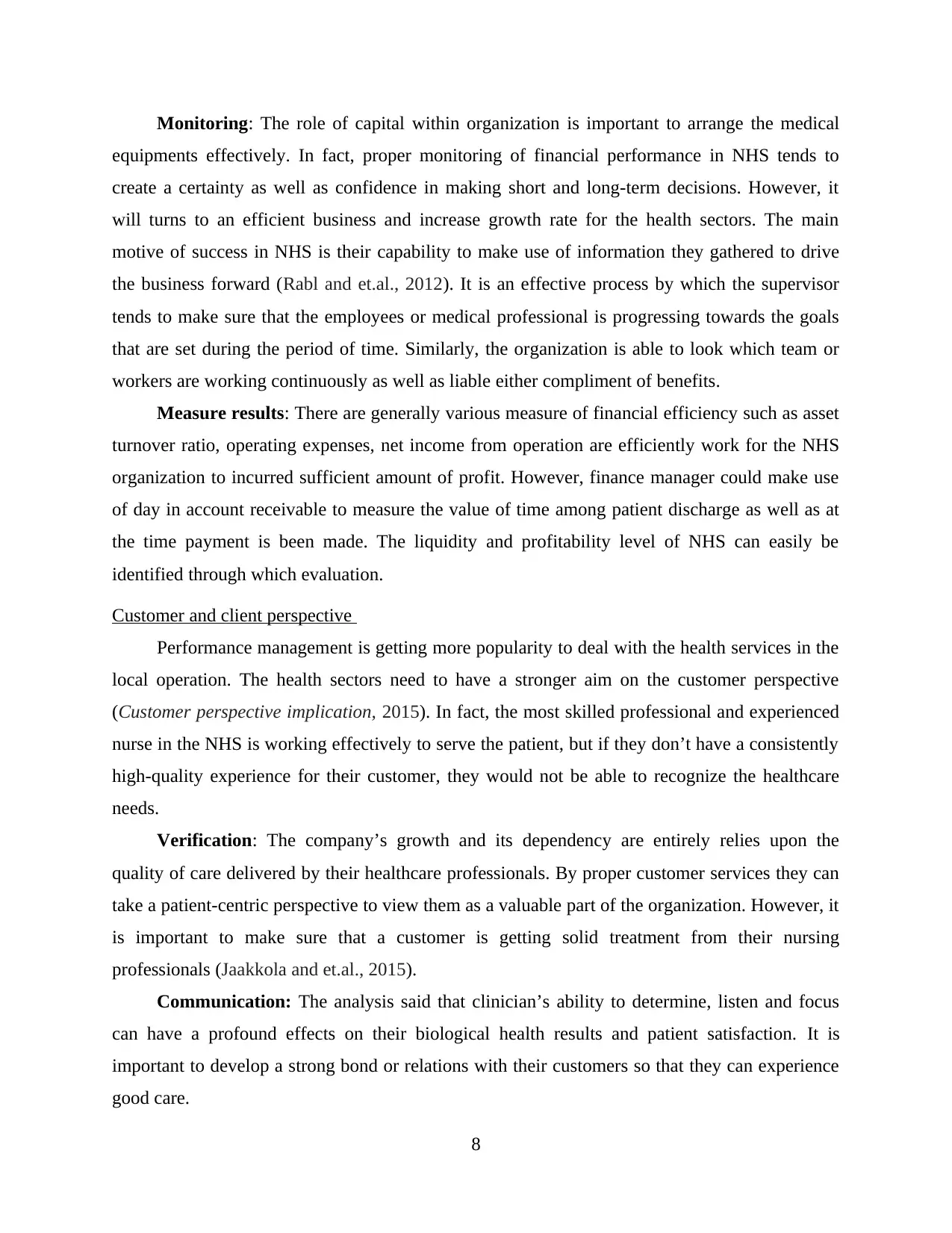
Monitoring: The role of capital within organization is important to arrange the medical
equipments effectively. In fact, proper monitoring of financial performance in NHS tends to
create a certainty as well as confidence in making short and long-term decisions. However, it
will turns to an efficient business and increase growth rate for the health sectors. The main
motive of success in NHS is their capability to make use of information they gathered to drive
the business forward (Rabl and et.al., 2012). It is an effective process by which the supervisor
tends to make sure that the employees or medical professional is progressing towards the goals
that are set during the period of time. Similarly, the organization is able to look which team or
workers are working continuously as well as liable either compliment of benefits.
Measure results: There are generally various measure of financial efficiency such as asset
turnover ratio, operating expenses, net income from operation are efficiently work for the NHS
organization to incurred sufficient amount of profit. However, finance manager could make use
of day in account receivable to measure the value of time among patient discharge as well as at
the time payment is been made. The liquidity and profitability level of NHS can easily be
identified through which evaluation.
Customer and client perspective
Performance management is getting more popularity to deal with the health services in the
local operation. The health sectors need to have a stronger aim on the customer perspective
(Customer perspective implication, 2015). In fact, the most skilled professional and experienced
nurse in the NHS is working effectively to serve the patient, but if they don’t have a consistently
high-quality experience for their customer, they would not be able to recognize the healthcare
needs.
Verification: The company’s growth and its dependency are entirely relies upon the
quality of care delivered by their healthcare professionals. By proper customer services they can
take a patient-centric perspective to view them as a valuable part of the organization. However, it
is important to make sure that a customer is getting solid treatment from their nursing
professionals (Jaakkola and et.al., 2015).
Communication: The analysis said that clinician’s ability to determine, listen and focus
can have a profound effects on their biological health results and patient satisfaction. It is
important to develop a strong bond or relations with their customers so that they can experience
good care.
8
equipments effectively. In fact, proper monitoring of financial performance in NHS tends to
create a certainty as well as confidence in making short and long-term decisions. However, it
will turns to an efficient business and increase growth rate for the health sectors. The main
motive of success in NHS is their capability to make use of information they gathered to drive
the business forward (Rabl and et.al., 2012). It is an effective process by which the supervisor
tends to make sure that the employees or medical professional is progressing towards the goals
that are set during the period of time. Similarly, the organization is able to look which team or
workers are working continuously as well as liable either compliment of benefits.
Measure results: There are generally various measure of financial efficiency such as asset
turnover ratio, operating expenses, net income from operation are efficiently work for the NHS
organization to incurred sufficient amount of profit. However, finance manager could make use
of day in account receivable to measure the value of time among patient discharge as well as at
the time payment is been made. The liquidity and profitability level of NHS can easily be
identified through which evaluation.
Customer and client perspective
Performance management is getting more popularity to deal with the health services in the
local operation. The health sectors need to have a stronger aim on the customer perspective
(Customer perspective implication, 2015). In fact, the most skilled professional and experienced
nurse in the NHS is working effectively to serve the patient, but if they don’t have a consistently
high-quality experience for their customer, they would not be able to recognize the healthcare
needs.
Verification: The company’s growth and its dependency are entirely relies upon the
quality of care delivered by their healthcare professionals. By proper customer services they can
take a patient-centric perspective to view them as a valuable part of the organization. However, it
is important to make sure that a customer is getting solid treatment from their nursing
professionals (Jaakkola and et.al., 2015).
Communication: The analysis said that clinician’s ability to determine, listen and focus
can have a profound effects on their biological health results and patient satisfaction. It is
important to develop a strong bond or relations with their customers so that they can experience
good care.
8
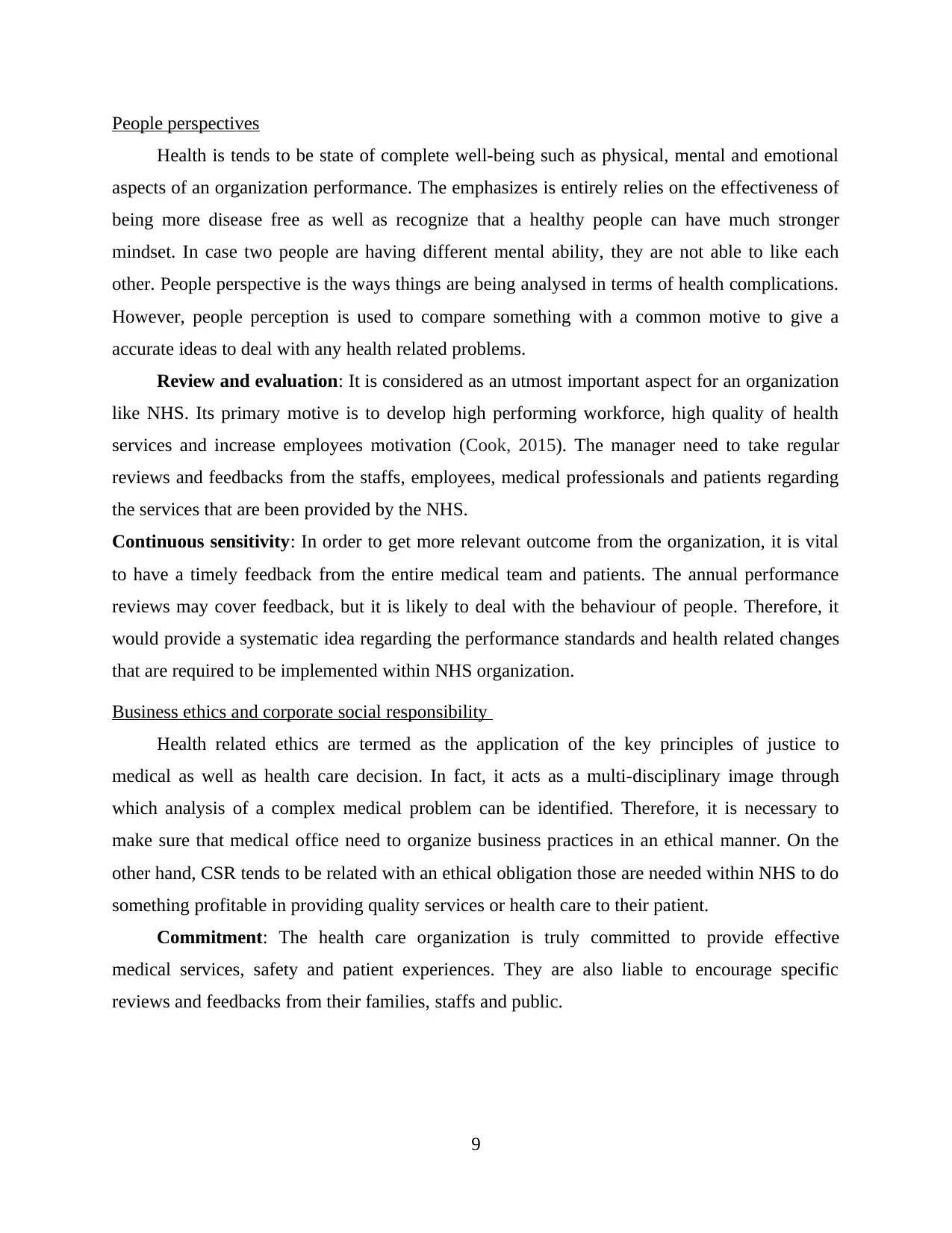
People perspectives
Health is tends to be state of complete well-being such as physical, mental and emotional
aspects of an organization performance. The emphasizes is entirely relies on the effectiveness of
being more disease free as well as recognize that a healthy people can have much stronger
mindset. In case two people are having different mental ability, they are not able to like each
other. People perspective is the ways things are being analysed in terms of health complications.
However, people perception is used to compare something with a common motive to give a
accurate ideas to deal with any health related problems.
Review and evaluation: It is considered as an utmost important aspect for an organization
like NHS. Its primary motive is to develop high performing workforce, high quality of health
services and increase employees motivation (Cook, 2015). The manager need to take regular
reviews and feedbacks from the staffs, employees, medical professionals and patients regarding
the services that are been provided by the NHS.
Continuous sensitivity: In order to get more relevant outcome from the organization, it is vital
to have a timely feedback from the entire medical team and patients. The annual performance
reviews may cover feedback, but it is likely to deal with the behaviour of people. Therefore, it
would provide a systematic idea regarding the performance standards and health related changes
that are required to be implemented within NHS organization.
Business ethics and corporate social responsibility
Health related ethics are termed as the application of the key principles of justice to
medical as well as health care decision. In fact, it acts as a multi-disciplinary image through
which analysis of a complex medical problem can be identified. Therefore, it is necessary to
make sure that medical office need to organize business practices in an ethical manner. On the
other hand, CSR tends to be related with an ethical obligation those are needed within NHS to do
something profitable in providing quality services or health care to their patient.
Commitment: The health care organization is truly committed to provide effective
medical services, safety and patient experiences. They are also liable to encourage specific
reviews and feedbacks from their families, staffs and public.
9
Health is tends to be state of complete well-being such as physical, mental and emotional
aspects of an organization performance. The emphasizes is entirely relies on the effectiveness of
being more disease free as well as recognize that a healthy people can have much stronger
mindset. In case two people are having different mental ability, they are not able to like each
other. People perspective is the ways things are being analysed in terms of health complications.
However, people perception is used to compare something with a common motive to give a
accurate ideas to deal with any health related problems.
Review and evaluation: It is considered as an utmost important aspect for an organization
like NHS. Its primary motive is to develop high performing workforce, high quality of health
services and increase employees motivation (Cook, 2015). The manager need to take regular
reviews and feedbacks from the staffs, employees, medical professionals and patients regarding
the services that are been provided by the NHS.
Continuous sensitivity: In order to get more relevant outcome from the organization, it is vital
to have a timely feedback from the entire medical team and patients. The annual performance
reviews may cover feedback, but it is likely to deal with the behaviour of people. Therefore, it
would provide a systematic idea regarding the performance standards and health related changes
that are required to be implemented within NHS organization.
Business ethics and corporate social responsibility
Health related ethics are termed as the application of the key principles of justice to
medical as well as health care decision. In fact, it acts as a multi-disciplinary image through
which analysis of a complex medical problem can be identified. Therefore, it is necessary to
make sure that medical office need to organize business practices in an ethical manner. On the
other hand, CSR tends to be related with an ethical obligation those are needed within NHS to do
something profitable in providing quality services or health care to their patient.
Commitment: The health care organization is truly committed to provide effective
medical services, safety and patient experiences. They are also liable to encourage specific
reviews and feedbacks from their families, staffs and public.
9
⊘ This is a preview!⊘
Do you want full access?
Subscribe today to unlock all pages.

Trusted by 1+ million students worldwide
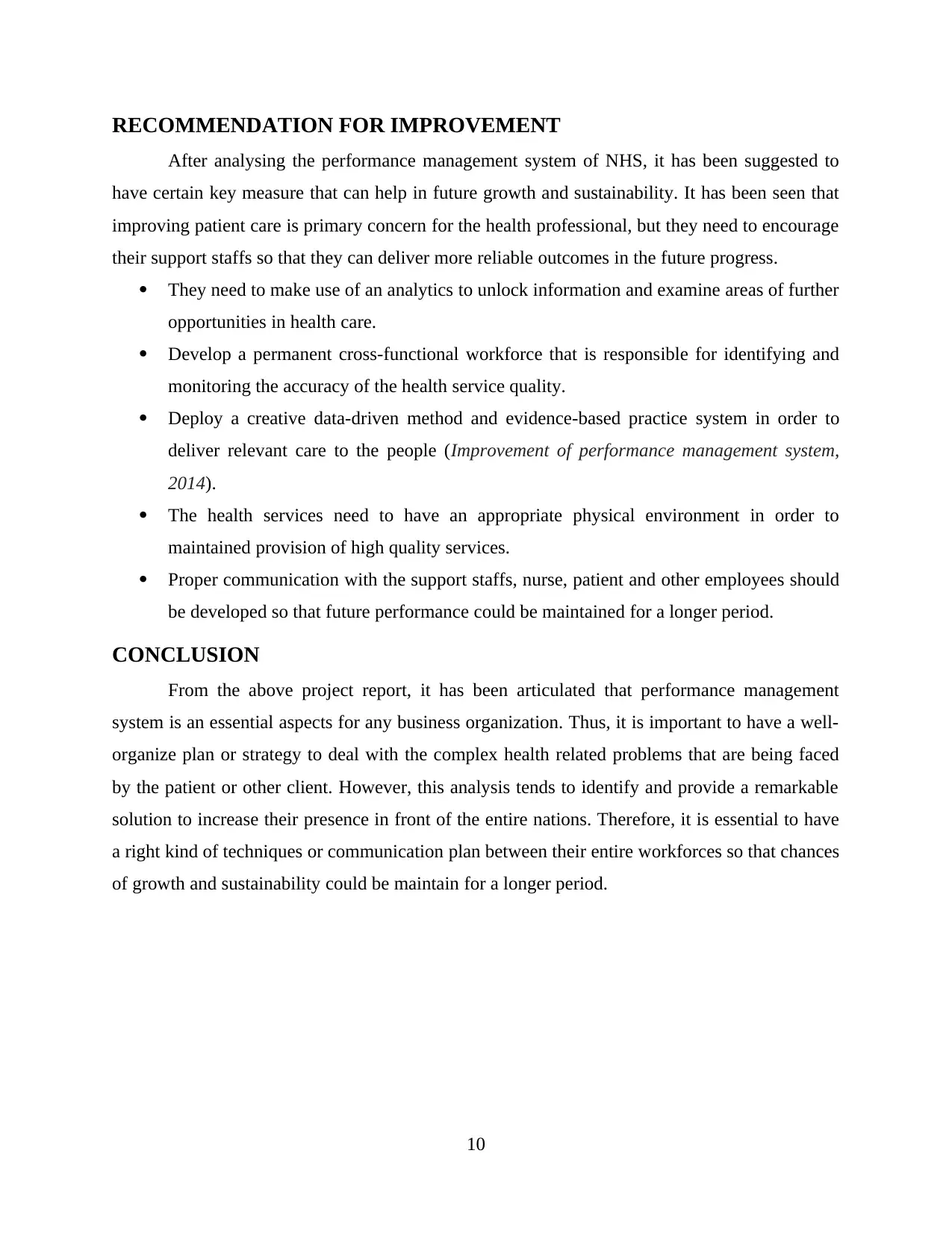
RECOMMENDATION FOR IMPROVEMENT
After analysing the performance management system of NHS, it has been suggested to
have certain key measure that can help in future growth and sustainability. It has been seen that
improving patient care is primary concern for the health professional, but they need to encourage
their support staffs so that they can deliver more reliable outcomes in the future progress.
They need to make use of an analytics to unlock information and examine areas of further
opportunities in health care.
Develop a permanent cross-functional workforce that is responsible for identifying and
monitoring the accuracy of the health service quality.
Deploy a creative data-driven method and evidence-based practice system in order to
deliver relevant care to the people (Improvement of performance management system,
2014).
The health services need to have an appropriate physical environment in order to
maintained provision of high quality services.
Proper communication with the support staffs, nurse, patient and other employees should
be developed so that future performance could be maintained for a longer period.
CONCLUSION
From the above project report, it has been articulated that performance management
system is an essential aspects for any business organization. Thus, it is important to have a well-
organize plan or strategy to deal with the complex health related problems that are being faced
by the patient or other client. However, this analysis tends to identify and provide a remarkable
solution to increase their presence in front of the entire nations. Therefore, it is essential to have
a right kind of techniques or communication plan between their entire workforces so that chances
of growth and sustainability could be maintain for a longer period.
10
After analysing the performance management system of NHS, it has been suggested to
have certain key measure that can help in future growth and sustainability. It has been seen that
improving patient care is primary concern for the health professional, but they need to encourage
their support staffs so that they can deliver more reliable outcomes in the future progress.
They need to make use of an analytics to unlock information and examine areas of further
opportunities in health care.
Develop a permanent cross-functional workforce that is responsible for identifying and
monitoring the accuracy of the health service quality.
Deploy a creative data-driven method and evidence-based practice system in order to
deliver relevant care to the people (Improvement of performance management system,
2014).
The health services need to have an appropriate physical environment in order to
maintained provision of high quality services.
Proper communication with the support staffs, nurse, patient and other employees should
be developed so that future performance could be maintained for a longer period.
CONCLUSION
From the above project report, it has been articulated that performance management
system is an essential aspects for any business organization. Thus, it is important to have a well-
organize plan or strategy to deal with the complex health related problems that are being faced
by the patient or other client. However, this analysis tends to identify and provide a remarkable
solution to increase their presence in front of the entire nations. Therefore, it is essential to have
a right kind of techniques or communication plan between their entire workforces so that chances
of growth and sustainability could be maintain for a longer period.
10
Paraphrase This Document
Need a fresh take? Get an instant paraphrase of this document with our AI Paraphraser
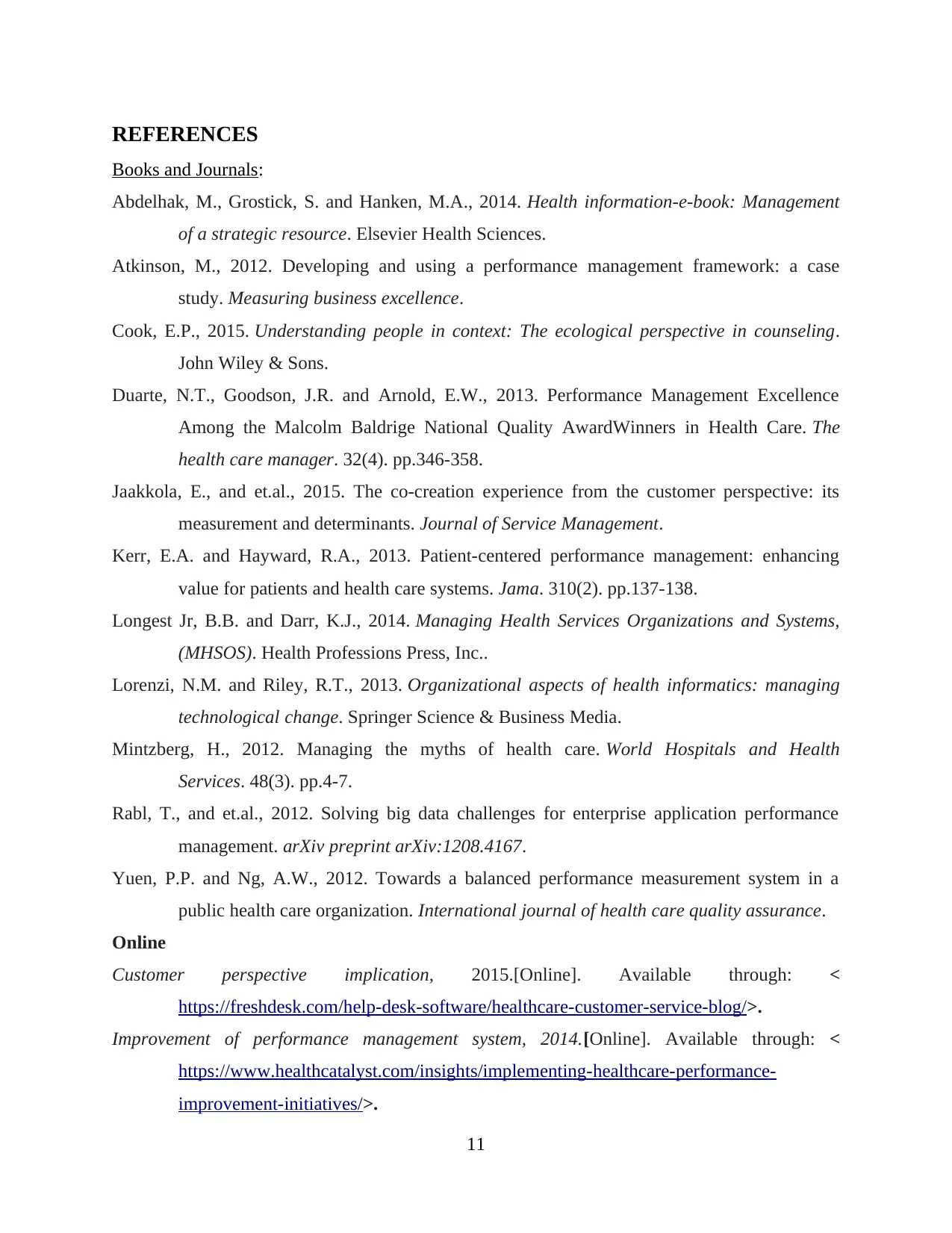
REFERENCES
Books and Journals:
Abdelhak, M., Grostick, S. and Hanken, M.A., 2014. Health information-e-book: Management
of a strategic resource. Elsevier Health Sciences.
Atkinson, M., 2012. Developing and using a performance management framework: a case
study. Measuring business excellence.
Cook, E.P., 2015. Understanding people in context: The ecological perspective in counseling.
John Wiley & Sons.
Duarte, N.T., Goodson, J.R. and Arnold, E.W., 2013. Performance Management Excellence
Among the Malcolm Baldrige National Quality AwardWinners in Health Care. The
health care manager. 32(4). pp.346-358.
Jaakkola, E., and et.al., 2015. The co-creation experience from the customer perspective: its
measurement and determinants. Journal of Service Management.
Kerr, E.A. and Hayward, R.A., 2013. Patient-centered performance management: enhancing
value for patients and health care systems. Jama. 310(2). pp.137-138.
Longest Jr, B.B. and Darr, K.J., 2014. Managing Health Services Organizations and Systems,
(MHSOS). Health Professions Press, Inc..
Lorenzi, N.M. and Riley, R.T., 2013. Organizational aspects of health informatics: managing
technological change. Springer Science & Business Media.
Mintzberg, H., 2012. Managing the myths of health care. World Hospitals and Health
Services. 48(3). pp.4-7.
Rabl, T., and et.al., 2012. Solving big data challenges for enterprise application performance
management. arXiv preprint arXiv:1208.4167.
Yuen, P.P. and Ng, A.W., 2012. Towards a balanced performance measurement system in a
public health care organization. International journal of health care quality assurance.
Online
Customer perspective implication, 2015.[Online]. Available through: <
https://freshdesk.com/help-desk-software/healthcare-customer-service-blog/>.
Improvement of performance management system, 2014.[Online]. Available through: <
https://www.healthcatalyst.com/insights/implementing-healthcare-performance-
improvement-initiatives/>.
11
Books and Journals:
Abdelhak, M., Grostick, S. and Hanken, M.A., 2014. Health information-e-book: Management
of a strategic resource. Elsevier Health Sciences.
Atkinson, M., 2012. Developing and using a performance management framework: a case
study. Measuring business excellence.
Cook, E.P., 2015. Understanding people in context: The ecological perspective in counseling.
John Wiley & Sons.
Duarte, N.T., Goodson, J.R. and Arnold, E.W., 2013. Performance Management Excellence
Among the Malcolm Baldrige National Quality AwardWinners in Health Care. The
health care manager. 32(4). pp.346-358.
Jaakkola, E., and et.al., 2015. The co-creation experience from the customer perspective: its
measurement and determinants. Journal of Service Management.
Kerr, E.A. and Hayward, R.A., 2013. Patient-centered performance management: enhancing
value for patients and health care systems. Jama. 310(2). pp.137-138.
Longest Jr, B.B. and Darr, K.J., 2014. Managing Health Services Organizations and Systems,
(MHSOS). Health Professions Press, Inc..
Lorenzi, N.M. and Riley, R.T., 2013. Organizational aspects of health informatics: managing
technological change. Springer Science & Business Media.
Mintzberg, H., 2012. Managing the myths of health care. World Hospitals and Health
Services. 48(3). pp.4-7.
Rabl, T., and et.al., 2012. Solving big data challenges for enterprise application performance
management. arXiv preprint arXiv:1208.4167.
Yuen, P.P. and Ng, A.W., 2012. Towards a balanced performance measurement system in a
public health care organization. International journal of health care quality assurance.
Online
Customer perspective implication, 2015.[Online]. Available through: <
https://freshdesk.com/help-desk-software/healthcare-customer-service-blog/>.
Improvement of performance management system, 2014.[Online]. Available through: <
https://www.healthcatalyst.com/insights/implementing-healthcare-performance-
improvement-initiatives/>.
11
1 out of 11
Related Documents
Your All-in-One AI-Powered Toolkit for Academic Success.
+13062052269
info@desklib.com
Available 24*7 on WhatsApp / Email
![[object Object]](/_next/static/media/star-bottom.7253800d.svg)
Unlock your academic potential
Copyright © 2020–2025 A2Z Services. All Rights Reserved. Developed and managed by ZUCOL.





